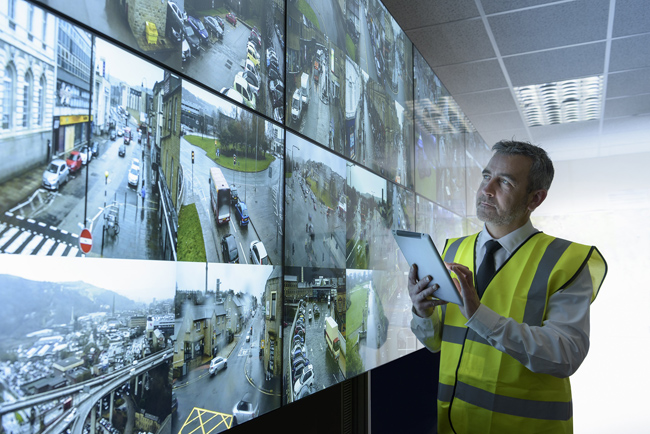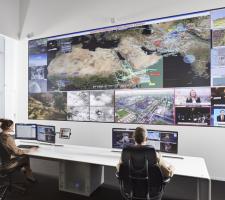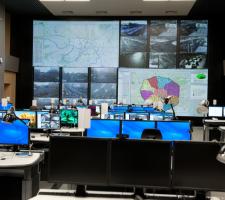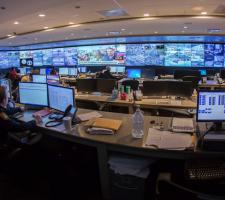
These things are always hard to pin down, but the shift to IP-based systems has been perhaps the biggest single advance in control room technology over the last decade. “The introduction of IP within the control room has had a huge effect on the industry - on the manufacturer side but also on the operator side,” says Cris Tanghe, product marketing director EMEA at Leyard. “Look, for example, to camera manufacturers: they had to change their complete hardware platform to cope with the transition from analogue to digital and from SD to HD - and now to 4K. Network infrastructure needs now to cope with an abundance of streamed content and high performance demands - the same for software providers such as VMS platforms and also visualisation companies.”
Tanghe suggests that the move towards IP also implies a vast increase of real-time available data for operators, either in terms of higher resolution cameras, track and trace maps, signs, other Internet of Things devices and even social media. Today’s networked systems and the IP-enabled world we live in has certainly led to an explosion of available data for control rooms to access, agrees David Griffiths, senior director of sales EMEA, enterprise at
He points out that display technology has also continued to improve, with a transition from CRT to rear projection, LCD and LED, resulting in crisper, clearer displays.
Tanghe says this “digital wave” has had an effect on Leyard’s portfolio, moving it from rear projection-based solutions based on lamps, to an era of solid-state technology with LED-based projection and high resolution or narrow pixel pitch videowalls based on direct LED. Processing solutions have also had to cope with these changes, he goes on, capturing different digital sources and distributing them in an intuitive way across different high-resolution videowalls.
Steve Murphy, managing director of Ultimate Visual Solutions (UVS), highlights the advances in networks, infrastructure and software applications which have allowed accurate, real-time data, including live CCTV images, to be obtained from all critical areas of any business operation, and to be able to display and distribute this data: “The effect has been to allow business operations to run more efficiently and to analyse and resolve issues more rapidly.”
Suchit Rout, head of the global segment marketing team at
Shift to IP-based systems
Technology is not the only thing to have changed, of course. The needs – and perhaps attitudes – of clients have also undergone something of a transformation in recent years. Murphy points out: “As the general public’s expectations for immediate/live information has escalated, businesses expect the same responsiveness from any control room systems, no matter what complexities lie behind providing these features.”
Suchit Rout thinks that the industry has responded well to this. “Control room supervisors are fully subscribing to the importance of purpose-built displays and content management platforms contributing to 24/7 operational uptime [which is] crucial for critical control rooms,” he says. Meanwhile, the industry is “embracing software capabilities that help them to collaborate with remote decision makers and hence are investing their attention to user experience and software-enabled capabilities”.
Although this impressive march of progress is welcome, these developments bring difficulties in their wake. “Yes, all this information is now available at the fingertips of the traffic operators,” says Tanghe. “However, they need to cope with more and more information, which creates an increased stress on their day-to-day job. They require more and more on visualisation technology to support them in making the correct decisions. Simpler and more intuitive user interfaces are required for an ever greater abundance of visualisation signals, as well as the requirement to monitor and to control the system and the signals on a growing number of (mobile) devices.” He echoes the point about an increasing demand to share content with other stakeholders in order to enable joint decision- making.
Customers also want to be embraced. “Clients now expect control rooms to be quiet, comfortable and uncluttered working spaces, with crisp and clear high brightness displays,” says David Griffiths at Christie. “We find clients are now seeking an end-to-end solution, with comprehensive support. Clients are now seeking much more flexibility in terms of what they can achieve, allowing staff to work in the most efficient way possible, and future-proofing the system so that additions can be made should they need to do so.”
Defence against cyberattacks
When it comes to naming the most important priorities in the sector, Rout cites reliability, and improving return on investment while lowering total cost of ownership.
Murphy is concerned about the need for constantly improving defences against cybersecurity attacks and looking at true global standards for things such as IP video encoding/decoding. Tanghe says that users themselves are the biggest priority. “The means of transport have changed as they need to cope more and more with congestion, road charges, lack of parking, fuel costs and others,” he explains. Sustainability, Mobility as a Service, smart cities – these are all things which require information gathering. “However, there is still the struggle of what to do with it. One, because there are so many data points available and secondly, how about the legislation? Who can see what and do they have the right to see and use it?” For smart cities control rooms, visualisation solutions based on LED technology are important for sustainability, he thinks: “They have a great power efficiency and there are also no consumables anymore; a direct LED wall can play for over 10 years when using it non-stop 24/7/365.”
For Griffiths, it is simple: “Mission-critical 24/7 reliability is key. If things go wrong, they need to be identified and remedied swiftly and easily. In terms of displays, the latest features such as hot-swappable tiles and remote power now allow operators to have simple contingencies in place to mitigate any issues.”
Functionality and ease of use are also vital, he thinks. “With the increase in data it is now more important than ever to be able to interpret and interact with information in as simple and efficient a manner as possible.”
LED display technology
So much for the past and present – what of the future? In the next five years, Rout sees “a lot more movement towards software and services”, with services mostly handled by specialised system integrators. “Software will enable a larger and closely integrated ecosystem that will follow control room decision makers’ existing workflows and improve decision-making processes.”
For Murphy, the introduction of LED display technology for general control room applications - as the resolution of the technology increases and the cost reduces – will be an important step for companies.
“Data and content distribution within the control room environment will continue to evolve,” suggests Griffiths. “In particular, teams that work together across more than one location, or within the same or different buildings, using a variety of interfaces and devices are increasingly popular. Not only is it a challenge to collect and manage the myriad sources, but it’s also a challenge to share data between sites and devices and then be able to collaborate effectively around the information. As such, the biggest step forward is likely to be processing data that originates in multiple formats and from multiple sources, and make it useful while balancing concerns for scalability, security, integration and ease of use.”
Finally, Tanghe sees artificial intelligence (AI) making more strides. “The visualisation technology is evolved in such a way that it can show the right info at the right time: most of the time the decision making lies still with the operator,” he says. “However, we will soon see the effect of AI within the traffic control room. Analysis will already be made for the operator and different options to resolve a situation will be proposed. But maybe also in predicting future incidents: AI and innovative software algorithms could help to simulate, and to anticipate the ‘next steps’ so that the impacts of incidents can be decreased or perhaps completely avoided.” Yet, even at that moment, should the operator be there as man-in-the middle and make the judgement call, he muses. The questions, it seems, continue.
Rise of artificial intelligence
So what is the biggest current pressure on the control room business? Cost? Legislation? Customer preferences? Technology changes? The latter, insists Suchit Rout at Barco. “Because it is not just the rate of change but the fear, uncertainty and doubt around what risks every new technology option unlocks,” Rout says. “Control rooms are mostly late-majority adopters - not because of any lesser knowledge but rather because the field imposes a seriously high expectation on uptime and the technology decision-maker must weigh adventurism against pragmatism to keep critical operations running 24/7.”
Cris Tanghe at Leyard says there is considerable pressure on traffic service providers to adapt their way of working to cope with user demands. “They need to monitor and visualise more and different information points,” Tanghe suggests. “This provides a big challenge for them, as they have now many different platforms available. The legislation part doesn’t always help them as well. Also all of this comes more and more with a pressure on effectiveness and cost reduction.”
Price and performance are the two main pressures, says David Griffiths at Christie. “In terms of technology they tend to go hand in hand, as can be seen in the trend for using LCD flat panels and the increasingly popular direct view LED displays. Economies of scale have kicked in as sales volumes have risen meaning that higher performing products are available at a lower price.”
Steve Murphy of Ultimate Visual Solutions, cites a different pressure: his biggest gripe is businesses announcing that their ‘new payment terms’ for suppliers have been extended to 60-plus days. “Too many clients [are] expecting suppliers to fund their purchases for too long a period, which affects cash flow,” he concludes.














